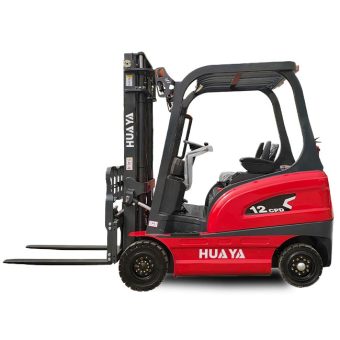
Nachrichten
Wenn es um den Kauf oder den Einsatz eines Gabelstaplers geht, ist das Gewicht eine der wichtigsten Überlegungen. Das Gewicht eines kleinen Gabelstaplers kann sich auf alles auswirken, von den Transportkosten bis hin zu den Bodenbelastungsgrenzen und der betrieblichen Effizienz. Wenn Sie wissen, wie viel ein kleiner Gabelstapler wiegt, welche Faktoren sein Gewicht beeinflussen und warum dies wichtig ist, können Sie fundiertere Entscheidungen treffen.

In diesem Blogbeitrag gehen wir auf das Durchschnittsgewicht von Kleinstaplern ein, auf die Faktoren, die dieses Gewicht beeinflussen, und darauf, warum es für Ihren Betrieb wichtig ist. Wir gehen auch auf häufig gestellte Fragen ein und bieten eine umfassende Zusammenfassung, um alles zusammenzufassen.
Bevor wir uns mit den Besonderheiten des Gewichts befassen, ist es wichtig zu definieren, was wir unter einem "kleinen Gabelstapler" verstehen. Im Allgemeinen handelt es sich bei kleinen Gabelstaplern um solche mit einer Tragfähigkeit von 1 bis 5 Tonnen. Diese Gabelstapler werden häufig in Branchen wie der Lagerhaltung, dem Einzelhandel und der Kleinproduktion eingesetzt, in denen keine schweren Hebearbeiten erforderlich sind. Durch ihre kompakte Größe und Wendigkeit sind sie ideal für den Einsatz in Innenräumen und auf engem Raum.
Das Gewicht eines kleinen Gabelstaplers kann aufgrund verschiedener Faktoren variieren, z. B. Art, Konstruktion und verwendete Materialien. Im Durchschnitt wiegt ein kleiner Gabelstapler zwischen 3.000 und 10.000 Pfund (1.360 bis 4.536 kg). Diese Spanne kann jedoch je nach Modell und Verwendungszweck variieren.
Ein Standard-Gabelstapler mit einer Tragfähigkeit von 3.000 Pfund wiegt zum Beispiel etwa 5.000 Pfund, während ein Gabelstapler mit einer Tragfähigkeit von 5.000 Pfund eher 9.000 Pfund wiegt. Es ist wichtig zu beachten, dass das Gewicht das Chassis des Gabelstaplers, die Batterie (bei Elektrostaplern) und andere wichtige Komponenten umfasst.
Mehrere Faktoren beeinflussen das Gewicht eines kleinen Gabelstaplers. Dazu gehören:
Elektro-Gabelstapler: In der Regel wiegen Elektrostapler aufgrund des Gewichts der Batterie mehr als ihre verbrennungsmotorischen Pendants (IC). Die Batterie allein kann einen erheblichen Teil des Gesamtgewichts ausmachen.
Gabelstapler mit Verbrennungsmotor: Verbrennungsmotorische Gabelstapler, die mit Diesel, Benzin oder Propan betrieben werden, wiegen in der Regel weniger als Elektrostapler, da sie keine schwere Batterie haben. Allerdings tragen der Motor und der Kraftstofftank zu ihrem Gesamtgewicht bei.
Je höher die Tragfähigkeit, desto schwerer ist der Gabelstapler. Ein Gabelstapler, der schwerere Lasten heben soll, benötigt einen robusteren Rahmen, ein größeres Gegengewicht und robustere Komponenten, wodurch sich das Gesamtgewicht erhöht.
Gabelstapler aus schwerem Stahl wiegen natürlich mehr als solche aus leichterem Material. Die Haltbarkeit und Festigkeit von Stahl sind jedoch für einen langfristigen Einsatz oft erforderlich.
Gabelstapler, die mit zusätzlichen Anbaugeräten wie Seitenschiebern, Klammern oder Spezialgabeln ausgestattet sind, wiegen mehr als solche mit Standardkonfiguration.
Das Gegengewicht ist eine wichtige Komponente, die dafür sorgt, dass der Gabelstapler beim Heben von Lasten stabil bleibt. Die Größe und das Gewicht des Gegengewichts tragen erheblich zum Gesamtgewicht des Gabelstaplers bei.
Die Kenntnis des Gewichts eines Gabelstaplers ist aus mehreren Gründen wichtig:
Beim Transport von Gabelstaplern, insbesondere über lange Strecken, ist die Kenntnis des Gewichts entscheidend für die Planung der Logistik, einschließlich der Art des benötigten Transportfahrzeugs und der Einhaltung der Gewichtsbeschränkungen auf der Straße.
Wenn Sie in geschlossenen Räumen arbeiten, müssen Sie unbedingt sicherstellen, dass der Boden das Gewicht des Gabelstaplers und seiner Last tragen kann. Das Überschreiten der Bodenbelastungsgrenzen kann zu strukturellen Schäden und Sicherheitsrisiken führen.
Ein schwerer Gabelstapler ist unter Umständen weniger wendig, insbesondere auf engem Raum. Wenn Sie das Gewicht Ihres Gabelstaplers kennen, können Sie feststellen, ob er für Ihr Betriebsumfeld geeignet ist.
Das Gewicht des Gabelstaplers wirkt sich auf seine Stabilität aus, insbesondere beim Heben schwerer Lasten. Ein schwerer Gabelstapler mit entsprechendem Gegengewicht ist weniger kippgefährdet, was die Sicherheit am Arbeitsplatz erhöht.
A: Ein Gabelstapler mit einer Tragfähigkeit von 3.000 Pfund wiegt in der Regel zwischen 4.000 und 5.000 Pfund, je nach Typ und zusätzlichen Funktionen.
A: Nicht unbedingt. Ein schwererer Gabelstapler kann zwar eine bessere Stabilität bieten, ist aber in engen Räumen möglicherweise nicht so wendig. Die beste Wahl hängt von Ihren spezifischen betrieblichen Anforderungen ab.
A: Elektrostapler wiegen aufgrund des zusätzlichen Gewichts der Batterie in der Regel mehr als verbrennungsmotorische Gabelstapler. Der Unterschied kann von ein paar hundert bis zu mehreren tausend Pfund reichen.
A: Das hängt vom Gewicht des Gabelstaplers und der Kapazität des Anhängers ab. Prüfen Sie immer die Tragfähigkeit des Anhängers und stellen Sie sicher, dass er den Straßenverkehrsvorschriften entspricht, bevor Sie einen Gabelstapler transportieren.
A: Die leichtesten Gabelstapler sind in der Regel Elektromodelle mit einer geringen Hubkapazität, die nicht mehr als 3.000 Pfund wiegen.
Das Gewicht eines kleinen Gabelstaplers zu kennen, ist für einen sicheren und effizienten Betrieb unerlässlich. Unabhängig davon, ob Sie den Kauf, den Transport oder den Betrieb eines Gabelstaplers planen, kann die Kenntnis des Gewichts Ihnen helfen, fundierte Entscheidungen zu treffen, die die Produktivität und Sicherheit erhöhen. Beachten Sie die Faktoren, die das Gewicht eines Gabelstaplers beeinflussen, wie z. B. Typ, Tragfähigkeit und Baumaterialien, um den richtigen Gabelstapler für Ihre Anforderungen auszuwählen.



